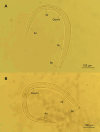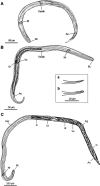The fourth-stage autoinfective larva of Strongyloides stercoralis: redescription and diagnostic implications
- PMID: 39636118
- PMCID: PMC11784425
- DOI: 10.1128/jcm.01021-24
The fourth-stage autoinfective larva of Strongyloides stercoralis: redescription and diagnostic implications
Abstract
Human strongyloidiasis is often underdiagnosed or misdiagnosed, which can relate to a lack of knowledge or recognition of the importance of particular developmental/larval stages of Strongyloides stercoralis in making an accurate diagnosis using parasitological methods (a morphological approach or morphological features/characters). Here, we report the identification of S. stercoralis autoinfective fourth-stage larvae (L4a) in naturally infected humans, encountered in two clinical cases in Australia. These larvae were identified in sputum (Case 1) and bronchoalveolar lavage (Case 2) specimens by direct wet-mount microscopy. The L4a of S. stercoralis can be morphologically differentiated from autoinfective third-stage larvae by its conical and pointed tail and a relatively mature genital primordium with an enlarged genital rudiment and the formation of a vulva within cuticle layers. This study emphasizes the need to consider these morphological features of the L4a stage for an accurate diagnosis of S. stercoralis infection. A detailed morphological description of this stage is given to guide laboratory practitioners and researchers in the identification and differentiation of this unique but neglected life-cycle stage of S. stercoralis.
Keywords: Strongyloides stercoralis; Strongyloidiasis; autoinfection; diagnosis; larva; life cycle stages.
Conflict of interest statement
The authors declare no conflict of interest.
Figures




References
Publication types
MeSH terms
LinkOut - more resources
Full Text Sources

